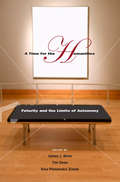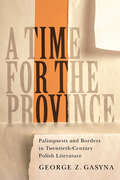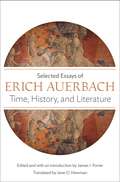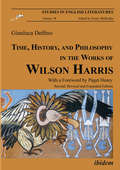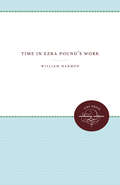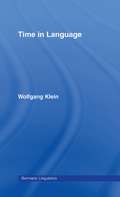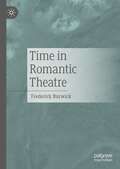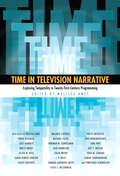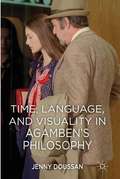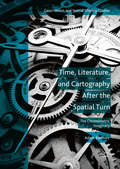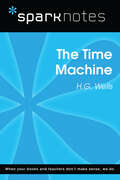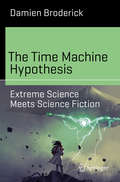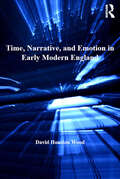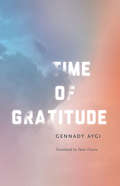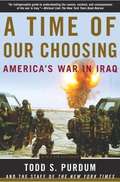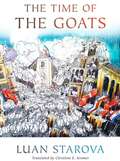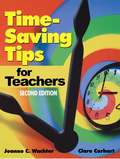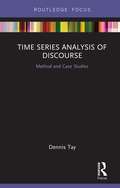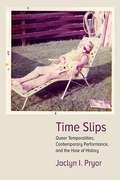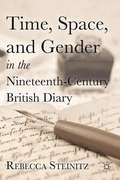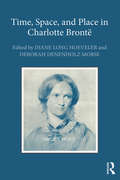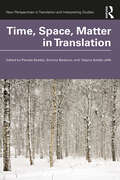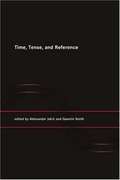- Table View
- List View
A Time for the Humanities: Futurity and the Limits of Autonomy
by Tim Dean Ewa Plonowska ZiarekThis book brings together an international roster of renowned scholars from disciplines including philosophy, political theory, intellectual history, and literary studies to address the conceptual foundations of the humanities and the question of their future. What notions of the future, of the human, and of finitude underlie recurring anxieties about the humanities in our current geopolitical situation? How can we think about the unpredictable and unthought dimensions of praxis implicit in the very notion of futurity?The essays here argue that the uncertainty of the future represents both an opportunity for critical engagement and a matrix for invention. Broadly conceived, the notion of invention, or cultural poiesis, questions the key assumptions and tasks of a whole range of practices in the humanities, beginning with critique, artistic practices, and intellectual inquiry, and ending with technology, emancipatory politics, and ethics. The essays discuss a wide range of key figures (e.g., Deleuze, Freud, Lacan, Foucault, Kristeva, Irigaray), problems (e.g., becoming, kinship and the foreign, "disposable populations" within a global political economy, queerness and the death drive, the parapoetic, electronic textuality, invention and accountability, political and social reform in Latin America), disciplines and methodologies (philosophy, art and art history, visuality, political theory, criticism and critique, psychoanalysis, gender analysis, architecture, literature, art). The volume should be required reading for all who feel a deep commitment to the humanities, its practices, and its future.
A Time for the Province: Palimpsests and Borders in Twentieth-Century Polish Literature
by George Z. GasynaWithin discourses on Polish provincial or marginal literature, the eastern borderlands are a richly symbolic region that inspires much fascination and study.Through close readings, surveys, and analyses of transborder narratives by seven modern writers who hailed from the Polish borderlands or set their works there, A Time for the Province demonstrates how the region has come to represent a palimpsest of cultural identities and myths as each new generation unearths and rediscovers them. George Gasyna explores and theorizes the province as a space of grand utopian visions and dystopic gestures about both the Polish past and a Polish future. Offering a novel literary and cultural history of modern Polish writing, he paves the way toward productive new modes of conceptualizing the cultural and literary forms that have come from Central Europe over the last century, challenging many basic assumptions about what this literature can offer its readership in Poland and around the world.Through engagement with the theoretical apparatuses of postmemory studies and border studies, A Time for the Province redefines Polish cultural identity in the current moment of postsocialist transition and globalized citizenship.
Time, History, and Literature: Selected Essays of Erich Auerbach
by Erich AuerbachImportant essays from one of the giants of literary criticism, including a dozen published here in English for the first timeErich Auerbach (1892-1957), best known for his classic literary study Mimesis, is celebrated today as a founder of comparative literature, a forerunner of secular criticism, and a prophet of global literary studies. Yet the true depth of Auerbach's thinking and writing remains unplumbed. Time, History, and Literature presents a wide selection of Auerbach's essays, many of which are little known outside the German-speaking world. Of the twenty essays culled for this volume from the full length of his career, twelve have never appeared in English before, and one is being published for the first time.Foregrounded in this major new collection are Auerbach's complex relationship to the Judaeo-Christian tradition, his philosophy of time and history, and his theory of human ethics and responsible action. Auerbach effectively charts out the difficult discovery, in the wake of Christianity, of the sensuous, the earthly, and the human and social worlds. A number of the essays reflect Auerbach's responses to an increasingly hostile National Socialist environment. These writings offer a challenging model of intellectual engagement, one that remains as compelling today as it was in Auerbach's own time.
Time, History, and Philosophy in the Works of Wilson Harris
by Gianluca DelfinoGianluca Delfino's study of one of the Caribbean's most controversial authors paves the way for looking at Wilson Harris's body of work in a new light. Harris's imaginative approach to reality is discussed in relation to the categories of history and time with reference to several novels, with a special focus on The Infinite Rehearsal, Jonestown, and The Dark Jester, spanning more than forty years of his vast literary production. Delfino's analysis, encompassing critical perspectives ranging from African philosophy to Jungian readings through historiography and anthropology, demonstrates that Harris's works as a whole show a remarkable unity of thought rooted in their author's complex imagination. As a result, the cross-cultural quality of Harris's thought emerges as a healing outcome of the traumatic colonial encounter, bringing together elements of Amerindian, African, and European origin in an ongoing dialogue with time, nature, and the psyche.
Time, History, and Philosophy in the Works of Wilson Harris (Studies in English Literatures #18)
by Gianluca DelfinoGianluca Delfino's encounter with one of the Caribbean's most controversial authors illuminates Wilson Harris's imaginative approach to history and time. Delfino references several novels, with a special focus on The Infinite Rehearsal (1987), Jonestown (1996), and The Dark Jester (2001). His analysis encompasses critical perspectives from African philosophy to Jungian readings, refracted through historiography and anthropology, demonstrating the remarkable unity that binds four decades of Harris's work. As a result, the cross-cultural quality of Harris's thought emerges as a healing outcome of the traumatic colonial encounter, bringing together elements of Amerindian, African, and European origin in an ongoing dialogue with time, nature, and the psyche.
Time in Ezra Pound's Work
by William HarmonThroughout nearly sixty-five of writing, Pound specialized on the suffocating effects of time on poetry, aesthetic form, and history. Harmon examines Pound's strategies for dealing with time and arrives at a persuasive reading of Pound's works in general and of the The Cantos in particular. By concentrating on a single theme and technique, the author demonstrates a coherence in the writing that elucidates the corpus for both the specialist and the casual reader.Originally published in 1977.A UNC Press Enduring Edition -- UNC Press Enduring Editions use the latest in digital technology to make available again books from our distinguished backlist that were previously out of print. These editions are published unaltered from the original, and are presented in affordable paperback formats, bringing readers both historical and cultural value.
Time in Language
by Wolfgang KleinThis book looks at the various ways in which time is reflected in natural language. All natural languages have developed a rich repetoire of devices to express time, but linguists have tended to concentrate on tense and aspect, rather than discourse principles. Klein considers the four main ways in which language expresses time - the verbal categories of tense and aspect; inherent lexical features of the verb; and various types of temporal adverbs. Klein looks at the interaction of these four devices and suggests new or partly new treatments of these devices to express temporality.
Time in Romantic Theatre
by Frederick BurwickThe shift in temporal modalities of Romantic Theatre was the consequence of internal as well as external developments: internally, the playwright was liberated from the old imperative of “Unity of Time” and the expectation that the events of the play must not exceed the hours of a single day; externally, the new social and cultural conformance to the time-keeping schedules of labour and business that had become more urgent with the industrial revolution. In reviewing the theatre of the Romantic era, this monograph draws attention to the ways in which theatre reflected the pervasive impact of increased temporal urgency in social and cultural behaviour. The contribution this book makes to the study of drama in the early nineteenth century is a renewed emphasis on time as a prominent element in Romantic dramaturgy, and a reappraisal of the extensive experimentation on how time functioned.
Time in Television Narrative: Exploring Temporality in Twenty-First Century Programming
by Melissa AmesThis collection analyzes twenty-first-century American television programs that employ temporal and narrative experimentation. These shows play with time, slowing it down to unfold narrative through time retardation and compression. They disrupt the chronological flow of time itself, using flashbacks and insisting that viewers be able to situate themselves in both the present and the past narrative threads. Although temporal play has existed on the small screen prior to the new millennium, never before has narrative time been so freely adapted in mainstream television. The essayists offer explanations for not only the frequency of time-play in contemporary programming, but also the implications of its sometimes disorienting presence.Drawing upon the fields of cultural studies, television scholarship, and literary studies, as well as overarching theories concerning postmodernity and narratology, Time in Television Narrative offers some critical suggestions. The increasing number of television programs concerned with time may stem from any and all of the following: recent scientific approaches to quantum physics and temporality; new conceptions of history and post history; or trends in late-capitalistic production and consumption, in the new culture of instantaneity, or in the recent trauma culture amplified after the September 11 attacks. In short, these televisual time experiments may very well be an aesthetic response to the climate from which they derive. These essays analyze both ends of this continuum and also attend to another crucial variable: the television viewer watching this new temporal play.
Time, Language, and Visuality in Agamben’s Philosophy
by Jenny DoussanGiorgio Agamben, a philosopher both celebrated and reviled, is among the prominent voices in contemporary Italian thought today. His work, which touches upon fields as diverse as aesthetics and biopolitics, is often understood within a framework of Aristotelian potentiality. With this incisive critique, Doussan identifies a different tendency in the philosopher's work, an engagement with the problem of time that is inextricably bound up with language and visuality. Founded in his early writings on metaphysics and continuing to his present occupation with inoperativity, Time, Language and Visuality in Agamben's Philosophy forges an original path through Agamben's extensive commentary on the linguistic and the visual to illuminate the recurrent temporal theme of capture and evasion the cat-and-mouse game that bears the foundational violence of not just representation but concept-formation itself. In the process, Doussan both reveals its limit and establishes a ground for future engagements. "
Time, Literature, and Cartography After the Spatial Turn
by Adam BarrowsTime, Literature and Cartography after the Spatial Turn argues that the spatial turn in literary studies has the unexplored potential to reinvigorate the ways in which we understand time in literature. Drawing on new readings of time in a range of literary narratives, including Vladimir Nabokov's Ada and James Joyce's Finnegans Wake, Adam Barrows explores literature's ability to cartographically represent the dense and tangled rhythmic processes that constitute lived spaces. Applying the insights of ecological resilience studies, as well as Henri Lefebvre's late work on rhythm to literary representations of time, this book offers a sustained examination of literature's "chronometric imaginary": its capacity to map the temporal relationships between the human and the non-human, the local and the global.
The Time Machine (SparkNotes Literature Guide Series)
by SparkNotesThe Time Machine (SparkNotes Literature Guide) by H.G. Wells Making the reading experience fun! Created by Harvard students for students everywhere, SparkNotes is a new breed of study guide: smarter, better, faster. Geared to what today's students need to know, SparkNotes provides: *Chapter-by-chapter analysis *Explanations of key themes, motifs, and symbols *A review quiz and essay topicsLively and accessible, these guides are perfect for late-night studying and writing papers
The Time Machine Hypothesis: Extreme Science Meets Science Fiction (Science and Fiction)
by Damien BroderickEvery age has characteristic inventions that change the world. In the 19th century it was the steam engine and the train. For the 20th, electric and gasoline power, aircraft, nuclear weapons, even ventures into space. Today, the planet is awash with electronic business, chatter and virtual-reality entertainment so brilliant that the division between real and simulated is hard to discern. But one new idea from the 19th century has failed, so far, to enter reality—time travel, using machines to turn the time dimension into a two-way highway. Will it come true, as foreseen in science fiction? Might we expect visits to and from the future, sooner than from space? That is the Time Machine Hypothesis, examined here by futurist Damien Broderick, an award-winning writer and theorist of the genre of the future. Broderick homes in on the topic through the lens of science as well as fiction, exploring some fifty different time-travel scenarios and conundrums found in the science fiction literature and film.
Time, Narrative, and Emotion in Early Modern England (Literary And Scientific Cultures Of Early Modernity Ser.)
by David Houston WoodExploiting a link between early modern concepts of the medical and the literary, David Houston Wood suggests that the recent critical attention to the gendered, classed, and raced elements of the embodied early modern subject has been hampered by its failure to acknowledge the role time and temporality play within the scope of these admittedly crucial concerns. Wood examines the ways that depictions of time expressed in early modern medical texts reveal themselves in contemporary literary works, demonstrating that the early modern recognition of the self as a palpably volatile entity, viewed within the tenets of contemporary medical treatises, facilitated the realistic portrayal of literary characters and served as a structuring principle for narrative experimentation. The study centers on four canonical, early modern texts notorious among scholars for their structural- that is, narrative, or temporal- difficulties. Wood displays the cogency of such analysis by working across a range of generic boundaries: from the prose romance of Philip Sidney's Arcadia, to the staged plays of William Shakespeare's Othello and The Winter's Tale, to John Milton's stubborn reliance upon humoral theory in shaping his brief epic (or closet drama), Samson Agonistes. As well as adding a new dimension to the study of authors and texts that remain central to early modern English literary culture, the author proposes a new method for analyzing the conjunction of character emotion and narrative structure that will serve as a model for future scholarship in the areas of historicist, formalist, and critical temporal studies.
Time of Gratitude
by Gennady Aygi Peter FranceA collection of extraordinary essays by one of the seminal Russian poets of the twentieth century Gennady Aygi’s longtime translator and friend Peter France has compiled this moving collection of tributes dedicated to some of the writers and artists who sustained him while living in the Moscow “underground.” Written in a quiet intensely expressive poetic style, Aygi’s inventive essays blend autobiography with literary criticism, social commentary, nature writing, and enlightening homage. He addresses such literary masters as Pasternak, Kafka, Mayakovsky, Celan, and Tomas Tranströmer, along with other writers from the Russian avant-garde and his native Chuvashia. Related poems by Aygi are also threaded between the essays. Reminiscent of Mandelstam’s elliptical travel musings and Kafka’s intensely spiritual jottings in his notebooks, Time of Gratitude glows with the love and humanity of a sacred vocation. “These leaves of paper," Aygi says, 'are swept up by the whirlwind of festivity; everything whirls—from Earth to Heaven—and perhaps the Universe too begins to swirl. Everything flows together in the rainbow colors and lights of the infinite world of Poetry.'
A Time of Our Choosing: America's War in Iraq
by Todd S. PurdumIt was a war like no other the United States had ever fought. It began with the bombing of Saddam Hussein’s bunker and ended with statues of the Iraqi dictator being toppled in downtown Baghdad, and it marked a turning point in America’s relations with its enemies, its allies, and its sense of itself. Yet most Americans experienced the war as impressionistic and often confusing—the story of one battle here, one unit there, a report from one city, then another, without the larger context we so urgently needed. Each reporter had his “slice” of the war, it seemed, but no one had the whole story or the broad view. A Time of Our Choosing fills that gap brilliantly, drawing on the unparalleled resources and reportage of The New York Times. Todd S. Purdum, one of the paper’s most gifted storytellers, traces the war in Iraq from the first rumblings after 9/11, to the diplomatic recriminations at the United Nations, to the battles themselves and their aftermath. He deftly rolls out the whole canvas before our eyes, showing how the individual “slices” fit together into a single, gripping drama. Purdum also explores the complex legacy of America’s near-unilateral action. Since the 9/11 attacks, President George W. Bush has vowed that the United States would confront its enemies “at a time of our choosing,” and Purdum shows in vivid terms what this choice has meant for our now transformed world.
The Time of the Goats
by Luan StarovaIt's the late 1940s in Skopje, Yugoslavia, in the critical year leading to Tito's break with Stalin. Pushed to leave mountain villages to become the new proletariat in urban factories, a flood of peasants crowds into Skopje--and with them, all of their goats. Suffering from hunger, Skopje's citizens welcome the newcomers. But municipal leaders are faced with a dilemma when the central government issues an order calling for the slaughter of the country's goat population. With food so scarce, will they hide the outlawed animals? Or will they comply with the edict and endure the bite of hunger? The Time of the Goatsis the second novel in Luan Starova's acclaimed multivolume Balkan saga. It follows the main characters fromMy Father's Booksand the tragicomic events of their lives in Skopje as the narrator's intellectual father and the head goatherd become friends. As local officials clumsily carry out absurd policies, Starova conveys the bonds of understanding and mutual support that form in Skopje's poorest neighborhoods. At once historical and allegorical, folkloric and fantastic,The Time of the Goatsdraws lyrically on Starova's own childhood.
Time-Saving Tips for Teachers (1-off Ser.)
by Joanne C. Wachter Clare CarhartPerfect for teachers who need help managing their time,Time Saving Tips for Teachers is structured for easy use. Flip through the chapters and apply the ideas that fit immediate needs and style—and includes more than sixty reproducible forms that can be used right away, covering student and parent information, reading and writing coaches, homework, standards for assignments, and supplies, just to name a few. New tips include portfolios, substitute teachers, email, handheld computers, and the Internet!Chapters provide ideas on how to save time without diminishing quality by:Communicating effectively—but brieflyManaging materialsPlanning the week aheadLearning to say "No"Using the Internet to save timeWorking with substitutes and volunteersCreating a filing system that saves timeAvoiding distractionsTreating yourself as a professionalThis guide helps teachers work smarter and enjoy life outside of teaching once again!
Time Series Analysis of Discourse: Method and Case Studies (Routledge Studies in Linguistics)
by Dennis TayThis volume serves as a comprehensive introduction to Time Series Analysis (TSA), used commonly in financial and engineering sciences, to demonstrate its potential to complement qualitative approaches in discourse analysis research. The book begins by discussing how time has previously been conceptualized in the literature, drawing on studies from variationist sociolinguistics, corpus linguistics, and Critical Discourse Analysis. The volume then segues into a discussion of how TSA is applied in other contexts in which observed values are expected to be dependent on earlier values, such as stock markets and sales figures, and introduces a range of discourse-specific contexts to show how the technique might be extended to analyze trends or shed further light on relevant themes in discourse over time. Each successive chapter features a different discourse context as a case study, from psychotherapy sessions, university lectures, and news articles, and looks at how studying different variables over time in each context – metaphors, involvement markers, and keywords, respectively – can contribute to a greater understanding of both present and future discourse activity in these settings. Taken together, this book highlights the value of TSA as a complementary approach to meaning-based analysis in discourse, making this ideal reading for graduate students and scholars in discourse analysis looking to employ quantitative methods in their research practice.
Time Slips: Queer Temporalities, Contemporary Performance, and the Hole of History
by Jaclyn I. PryorPryor illuminates how each artist deploys performance as a tool to render history visible, trauma recognizable, and transformation possible by laying bare the histories and ongoing systems of violence woven deep into our society.
Time, Space, and Gender in the Nineteenth-Century British Diary
by Rebecca SteinitzThrough close examinations of diaries, diary publication, and diaries in fiction, this book explores how the diary's construction of time and space made it an invaluable and effective vehicle for the dominant discourses of the period; it also explains how the genre evolved into the feminine, emotive, private form we continue to privilege today.
Time, Space, and Motion in the Age of Shakespeare
by Angus FletcherTheirs was a world of exploration and experimentation, of movement and growth--and in this, the thinkers of the Renaissance, poets and scientists alike, followed their countrymen into uncharted territory and unthought space. A book that takes us to the very heart of the enterprise of the Renaissance, this closely focused but far-reaching work by the distinguished scholar Angus Fletcher reveals how early modern science and English poetry were in many ways components of one process: discovering and expressing the secrets of motion, whether in the language of mathematics or verse. Throughout his book, Fletcher is concerned with one main crisis of knowledge and perception, and indeed cognition generally: the desire to find a correct theory of motion that could only end with Newton's Laws. Beginning with the achievement of Galileo--which changed the world--Time, Space, and Motion identifies the problem of motion as the central cultural issue of the time, pursued through the poetry of the age, from Marlowe and Shakespeare to Ben Jonson and Milton, negotiated through the limits and the limitless possibilities of language much as it was through the constraints of the physical world.
Time, Space, and Place in Charlotte Brontë
by Deborah Denenholz Morse Diane Long HoevelerOrganized thematically around the themes of time, space, and place, this collection examines Charlotte Brontë in relationship to her own historical context and to her later critical reception, takes up the literal and metaphorical spaces of her literary output, and sheds light on place as both a psychic and geographical phenomenon in her novels and their adaptations. Foregrounding both a historical and a broad cultural approach, the contributors also follow the evolution of Brontë's literary reputation in essays that place her work in conversation with authors such as Samuel Richardson, Walter Scott, and George Sand and offer insights into the cultural and critical contexts that influenced her status as a canonical writer. Taken together, the essays in this volume reflect the resurgence of popular and scholarly interest in Charlotte Brontë and the robust expansion of Brontë studies that is currently under way.
Time, Space, Matter in Translation (New Perspectives in Translation and Interpreting Studies)
by Pamela Beattie Simona Bertacco Tatjana Soldat-JaffeTime, Space, Matter in Translation considers time, space, and materiality as legitimate habitats of translation. By offering a linked series of interdisciplinary case studies that show translation in action beyond languages and texts, this book provides a capacious and innovative understanding of what translation is, what it does, how, and where. The volume uses translation as a means through which to interrogate processes of knowledge transfer and creation, interpretation and reading, communication and relationship building—but it does so in ways that refuse to privilege one discipline over another, denying any one of them an entitled perspective. The result is a book that is grounded in the disciplines of the authors and simultaneously groundbreaking in how its contributors incorporate translation studies into their work. This is key reading for students in comparative literature—and in the humanities at large—and for scholars interested in seeing how expanding intellectual conversations can develop beyond traditional questions and methods.
Time, Tense, and Reference
by Aleksandar Jokic Quentin SmithAmong the many branches of philosophy, the philosophy of time and the philosophy of language are more intimately interconnected than most, yet their practitioners have long pursued independent paths. This book helps to bridge the gap between the two groups.
